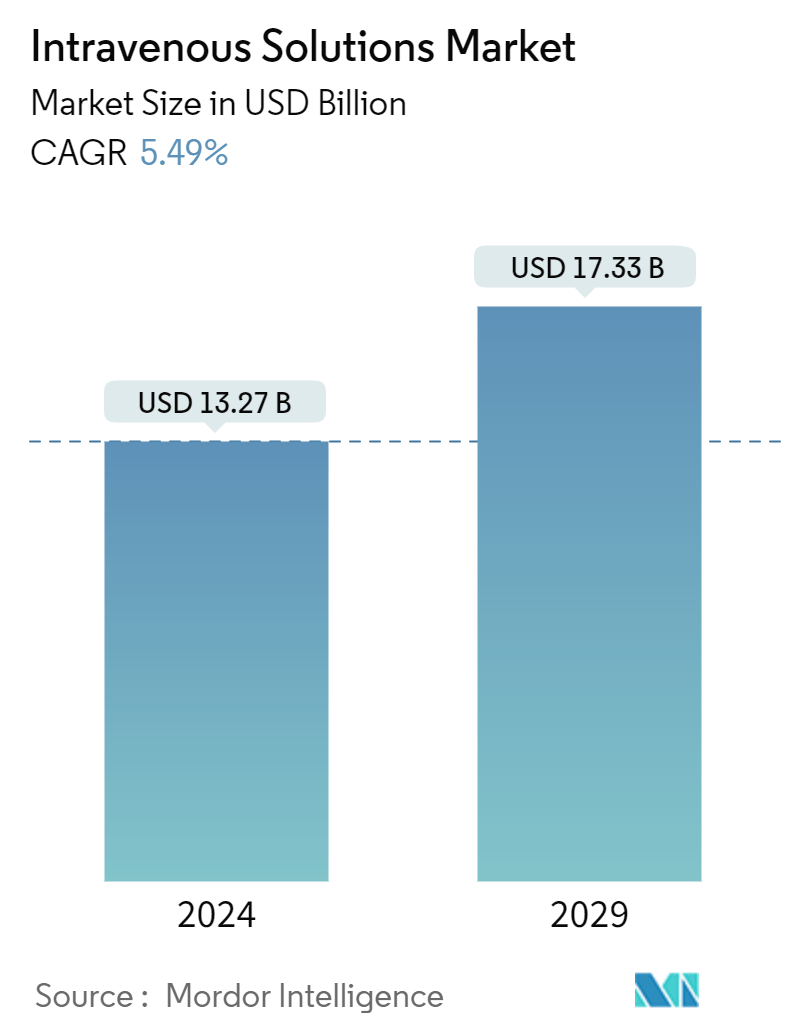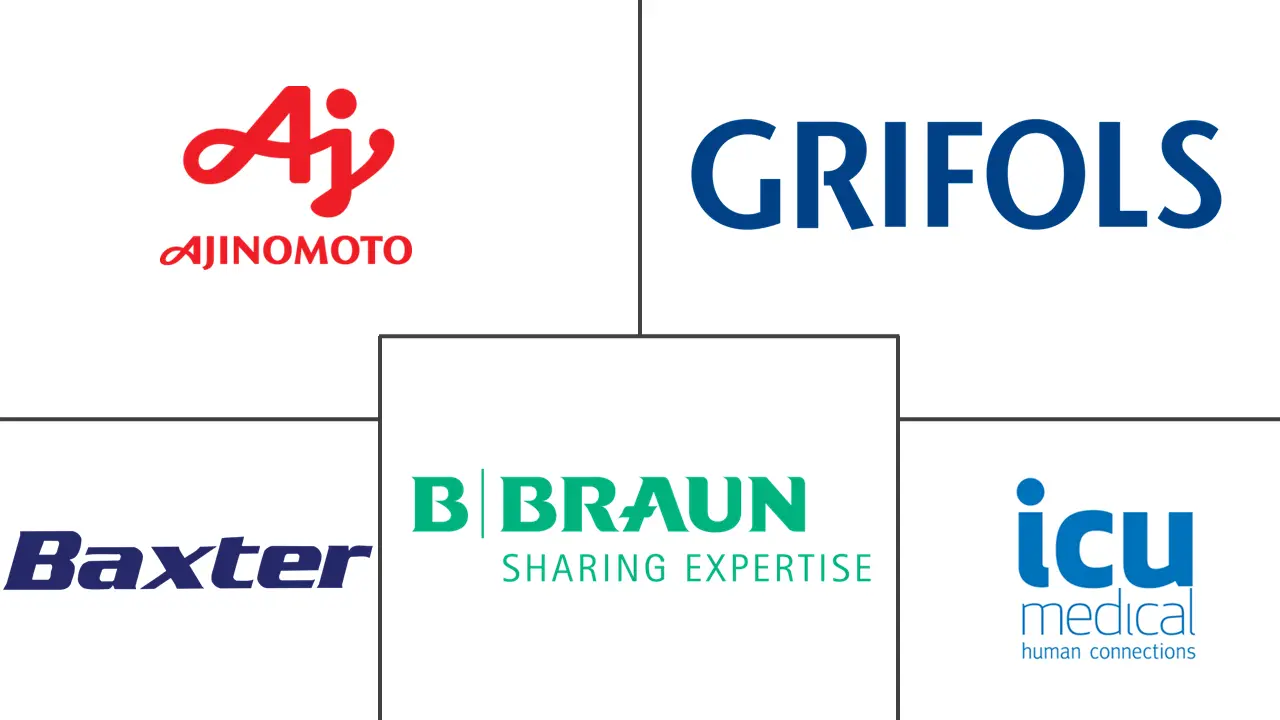Market Size of Intravenous Solutions Industry

| Study Period | 2019 - 2029 |
| Market Size (2024) | USD 13.27 Billion |
| Market Size (2029) | USD 17.33 Billion |
| CAGR (2024 - 2029) | 5.49 % |
| Fastest Growing Market | Asia Pacific |
| Largest Market | North America |
| Market Concentration | Medium |
Major Players
*Disclaimer: Major Players sorted in no particular order |
Intravenous Solutions Market Analysis
The Intravenous Solutions Market size is estimated at USD 13.27 billion in 2024, and is expected to reach USD 17.33 billion by 2029, at a CAGR of 5.49% during the forecast period (2024-2029).
The rising prevalence of chronic diseases, including gastrointestinal disorders, neurological conditions, and cancer, significantly propels intravenous solutions market growth as it plays a critical role in patient care. Cancer's impact on the body includes the depletion of vital resources, which alters metabolism and can lead to starvation and loss of lean body mass, ultimately resulting in malnutrition; this is particularly concerning given the rising incidence of the disease. For instance, according to a report published in the CA: Cancer Journal for Clinicians in January 2024, an estimated 2 million cancer cases are expected to be diagnosed in the United States in 2024. Thus, the anticipated increase in cancer diagnoses is driving demand for advanced therapeutic interventions, including intravenous solutions, as they play a critical role in the management and treatment of cancer-related symptoms and complications.
Moreover, the growing prevalence of pneumonia in recent years is also expected to boost the intravenous solutions market growth. For instance, according to a report published by the United Nations International Children's Emergency Fund in November 2023, globally, pneumonia affects over 1,400 children per 100,000 annually. The highest incidence rates are observed in South Asia, with 2,500 cases per 100,000 children, and in West and Central Africa, 1,620 cases per 100,000 children. Thus, the rising incidence of pneumonia, leading to increased hospitalizations and the need for intensive care treatments, drives the demand for intravenous solutions to support hydration, nutrition, and medication delivery in critical patient care.
Additionally, key players are implementing diverse growth strategies, including partnerships, to address the increasing demand for intravenous solutions. For instance, in October 2023, FranDevCo entered into a strategic partnership with IV Nutrition, a company specializing in intravenous hydration therapy. This collaboration aims to enhance wellness by providing essential nutrient therapies, reflecting the growing demand within the nutritional IVs market.
In conclusion, the rising prevalence of chronic diseases, including cancer and pneumonia, and advancements in intravenous solutions significantly drive the demand for specialized interventions in patient care, contributing to market growth.
However, regulatory and quality requirements are estimated to restrain the market growth.
Intravenous Solutions Industry Segmentation
As per the report's scope, intravenous solutions are chemically prepared fluids administered in the body through venous circulation to maintain or replace the level of lost body fluid. The intravenous solutions market is segmented by type, solution composition, end-user, and geography. The type segment is further bifurcated into total and peripheral parenteral solutions. The solution composition is further divided into saline, carbohydrates, vitamins and minerals, and other solution compositions. The end-user segment is further segmented into hospitals and clinics, ambulatory centers, and home care settings. The geography segment is divided into North America, Europe, Asia-Pacific, Middle East, and Africa. The market report also covers the estimated market sizes and trends for 17 countries across major regions globally. The report offers the value in USD for the above segments.
| By Type | |
| Total Parenteral Nutrition | |
| Peripheral Parenteral Nutrition |
| By Solution Composition | |
| Saline | |
| Carbohydrates | |
| Vitamins and Minerals | |
| Other Solution Compositions |
| By End-User | |
| Hospitals and Clinics | |
| Ambulatory Centers | |
| Homecare Settings |
| Geography | ||||||||
| ||||||||
| ||||||||
| ||||||||
| ||||||||
|
Intravenous Solutions Market Size Summary
The intravenous solutions market is experiencing a positive trajectory, driven by the increasing prevalence of chronic diseases such as gastrointestinal, neurological disorders, and cancer. These conditions necessitate the use of intravenous solutions as a primary source of energy and nutrition for patients, particularly in intensive care settings. The market's growth has been further accelerated by the COVID-19 pandemic, which heightened the demand for IV solutions to manage patient care in ICUs and spurred research into IV-based treatments. Innovations in product offerings, such as premixed solutions and portable packages, are enhancing convenience and reducing waste, thereby attracting more consumers. However, the market faces challenges due to stringent regulatory and quality requirements, which add complexity and cost to the production of intravenous solutions.
The United States is poised to be a significant contributor to the market's expansion, driven by a high burden of chronic diseases, a rising number of preterm births, and an increasing frequency of surgeries. The geriatric population, which is more susceptible to chronic conditions, is also expected to drive demand for intravenous solutions. Major market players are investing in research and development to introduce new treatments, which is expected to further propel market growth. The competitive landscape is characterized by the presence of key players such as Ajinomoto, B. Braun Melsungen AG, Baxter International, Grifols, and ICU Medical Inc., who are actively engaging in strategic initiatives to enhance their market position.
Intravenous Solutions Market Size - Table of Contents
-
1. MARKET DYNAMICS
-
1.1 Market Overview
-
1.2 Market Drivers
-
1.2.1 Increase in Prevalence of Chronic Diseases
-
1.2.2 Rise in Adoption of IV Solutions Coupled with Surge in the Prevalence of Malnutrition
-
-
1.3 Market Restraints
-
1.3.1 Regulatory and Quality Requirements
-
-
1.4 Porter's Five Forces Analysis
-
1.4.1 Threat of New Entrants
-
1.4.2 Bargaining Power of Buyers/Consumers
-
1.4.3 Bargaining Power of Suppliers
-
1.4.4 Threat of Substitute Products
-
1.4.5 Intensity of Competitive Rivalry
-
-
-
2. MARKET SEGMENTATION (Market Size by Value - USD million)
-
2.1 By Type
-
2.1.1 Total Parenteral Nutrition
-
2.1.2 Peripheral Parenteral Nutrition
-
-
2.2 By Solution Composition
-
2.2.1 Saline
-
2.2.2 Carbohydrates
-
2.2.3 Vitamins and Minerals
-
2.2.4 Other Solution Compositions
-
-
2.3 By End-User
-
2.3.1 Hospitals and Clinics
-
2.3.2 Ambulatory Centers
-
2.3.3 Homecare Settings
-
-
2.4 Geography
-
2.4.1 North America
-
2.4.1.1 United States
-
2.4.1.2 Canada
-
2.4.1.3 Mexico
-
-
2.4.2 Europe
-
2.4.2.1 Germany
-
2.4.2.2 United Kingdom
-
2.4.2.3 France
-
2.4.2.4 Italy
-
2.4.2.5 Spain
-
2.4.2.6 Rest of Europe
-
-
2.4.3 Asia-Pacific
-
2.4.3.1 China
-
2.4.3.2 Japan
-
2.4.3.3 India
-
2.4.3.4 Australia
-
2.4.3.5 South Korea
-
2.4.3.6 Rest of Asia-Pacific
-
-
2.4.4 Middle East and Africa
-
2.4.4.1 GCC
-
2.4.4.2 South Africa
-
2.4.4.3 Rest of Middle East and Africa
-
-
2.4.5 South America
-
2.4.5.1 Brazil
-
2.4.5.2 Argentina
-
2.4.5.3 Rest of South America
-
-
-
Intravenous Solutions Market Size FAQs
How big is the Intravenous Solutions Market?
The Intravenous Solutions Market size is expected to reach USD 13.27 billion in 2024 and grow at a CAGR of 5.49% to reach USD 17.33 billion by 2029.
What is the current Intravenous Solutions Market size?
In 2024, the Intravenous Solutions Market size is expected to reach USD 13.27 billion.

